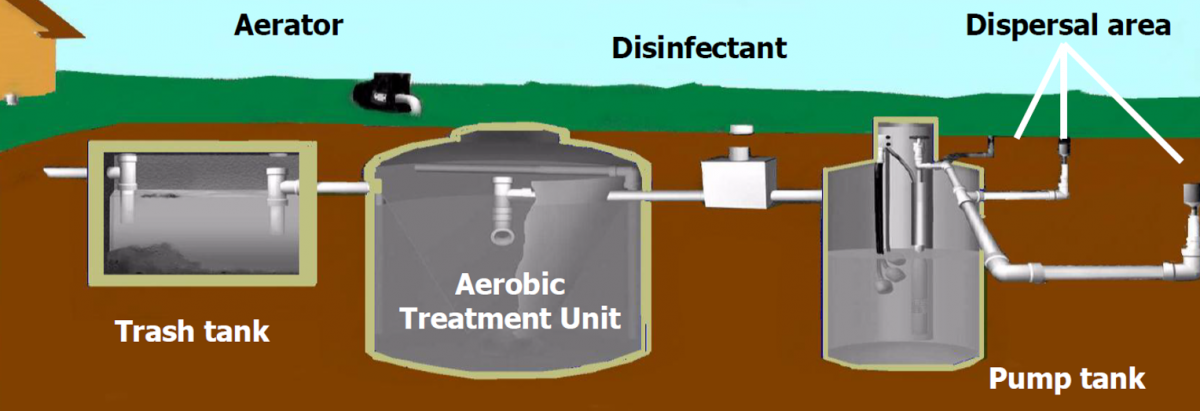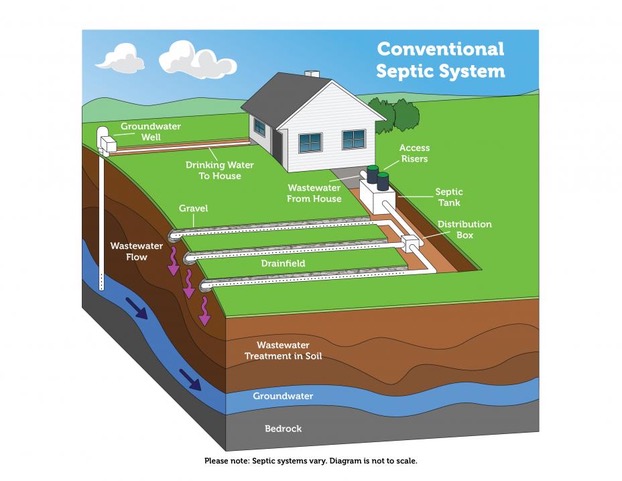What is a Septic System?
A septic system—or on-site sewage facility (OFFS)—is a method of dealing with household wastewater in areas where city sewer is not available. There are many types of OSSFs. Most people use the term “septic system” very generally, which may include all types of on-site sewage facilities. A typical standard septic system consists of a septic tank (to separate the solids from the liquids) and an absorption area where the liquids are treated in the soil before returning to the groundwater supply.
Different Types of Septic Systems
AEROBIC SYSTEM
How Does a Aerobic system work?
In onsite wastewater treatment systems, micro- organisms convert waste into less harmful substances—water, carbon dioxide, and new cells. Aerobic treatment systems consist of several processes that work together to provide a high-quality effluent:
- Removal of gross solids (trash): After the wastewater leaves the house through a pipe, it enters a trash or septic tank, where the solids in the wastewater settle to the bottom or float to the surface.
- Aeration: Air is pumped into the aeration chamber of the unit, and the wastewater remains in the chamber long enough to allow the microbes to convert the waste. Aerobic systems must have a continuous supply of oxygen to keep the microbes healthy.
- Clarification: The clarifier removes the microbial cells, cell waste, and dead cells from the wastewater.
- Sludge return: The solids that settle in the clarifier are returned to a previous component to be treated further.
- Disinfection: Systems using spray distribution of effluent include a disinfection unit as part of the treatment system. In the disinfection process, disease-causing organisms are destroyed or inactivated. However, the wastewater is only disinfected, not sterilized (free of all life). The main disinfectants used in aerobic systems are chlorine and ultraviolet light.
-Chlorination is the most common form of disinfection for aerobic systems. In this process, chlorine is added to the wastewater to reduce the number of pathogens in it. The chlorine oxidizes and destroys the cell enzymes of the pathogens. There are two types of chlorinators—tablet chlorinators and liquid chlorinators. Chlorine tablets release chlorine gas. Do not store chlorine tablets in the house, garage or storage areas with metal tools.
-Ultraviolet (UV) light is another disinfectant for wastewater. In this process, a lamp emits UV light into a chamber or zone as wastewater passes through the chamber. The UV light destroys the microorganisms in the effluent by altering their genetic material and retarding their ability to reproduce.
Spray fields
In the final stages of treatment and dispersal, the water is dispersed into the soil. Systems that spray the effluent onto lawns are called spray fields. For these systems, the effluent must be disinfected to reduce the risk of human exposure to pathogens. Although a spray field is like a lawn sprinkler, it should be viewed very differently. The water being distributed is treated wastewater—not drinking water. Residents and pets should avoid contact with it. Texas regulations specifically prohibit effluent from being applied to vegetable gardens because some pathogens are resistant to disinfection.
CONVENTIONAL SEPTIC SYSTEM
How Does a Conventional Septic System Work?
A conventional septic tank works by filtering wastewater through a series of pipes and chambers in the tank. The four basic components are:
- Septic tank – This is a partially buried concrete or plastic container that holds wastewater long enough for solids to settle out so they can be removed from the liquid by percolating through the soil into the drain field.
- Pump chamber – A small chamber located above the outlet of the septic tank that allows air into the liquid. This makes it so it can flow out of this part of the system without splashing onto its walls.
- Drain field – A field of perforated pipes placed at least six inches below ground level and connected by open trenches . Or it can be above-ground piping to carry sewage from the septic tank to an absorption area (drainage field). From here it filters through native soil and rock layers before entering groundwater aquifers or streams.
- Absorption field system – The absorption field system contains gravel or sand through which wastewater flows. This system allows solid matter to settle out and also absorbs excess liquid. This reduces the amount that reaches the drain field.



